同位语从句用法小结
- 格式:doc
- 大小:17.00 KB
- 文档页数:2
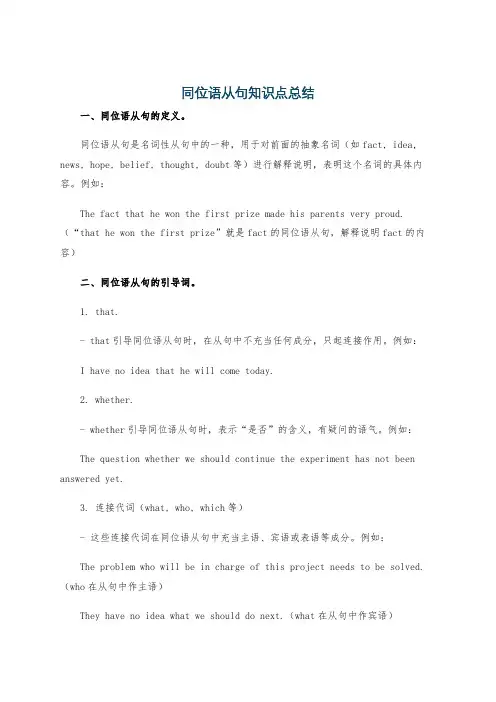
同位语从句知识点总结一、同位语从句的定义。
同位语从句是名词性从句中的一种,用于对前面的抽象名词(如fact, idea, news, hope, belief, thought, doubt等)进行解释说明,表明这个名词的具体内容。
例如:The fact that he won the first prize made his parents very proud.(“that he won the first prize”就是fact的同位语从句,解释说明fact的内容)二、同位语从句的引导词。
1. that.- that引导同位语从句时,在从句中不充当任何成分,只起连接作用。
例如:I have no idea that he will come today.2. whether.- whether引导同位语从句时,表示“是否”的含义,有疑问的语气。
例如:The question whether we should continue the experiment has not been answered yet.3. 连接代词(what, who, which等)- 这些连接代词在同位语从句中充当主语、宾语或表语等成分。
例如:The problem who will be in charge of this project needs to be solved.(who在从句中作主语)They have no idea what we should do next.(what在从句中作宾语)4. 连接副词(when, where, why, how等)- 连接副词在同位语从句中充当状语。
例如:We have no idea when he will come back.(when在从句中作时间状语)The question why he was late has not been answered.(why在从句中作原因状语)三、同位语从句与定语从句的区别。
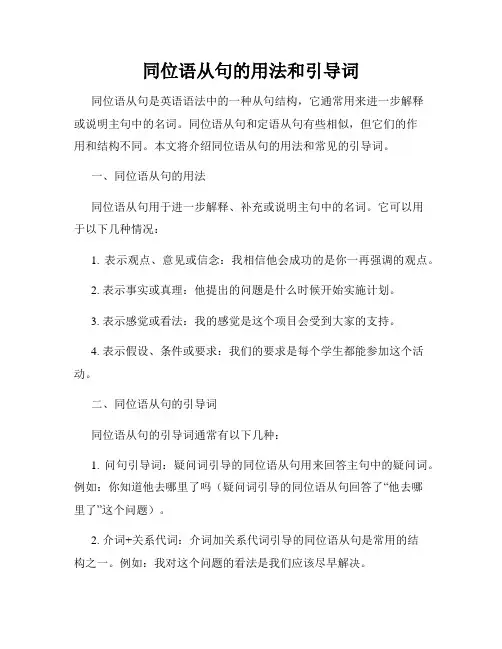
同位语从句的用法和引导词同位语从句是英语语法中的一种从句结构,它通常用来进一步解释或说明主句中的名词。
同位语从句和定语从句有些相似,但它们的作用和结构不同。
本文将介绍同位语从句的用法和常见的引导词。
一、同位语从句的用法同位语从句用于进一步解释、补充或说明主句中的名词。
它可以用于以下几种情况:1. 表示观点、意见或信念:我相信他会成功的是你一再强调的观点。
2. 表示事实或真理:他提出的问题是什么时候开始实施计划。
3. 表示感觉或看法:我的感觉是这个项目会受到大家的支持。
4. 表示假设、条件或要求:我们的要求是每个学生都能参加这个活动。
二、同位语从句的引导词同位语从句的引导词通常有以下几种:1. 问句引导词:疑问词引导的同位语从句用来回答主句中的疑问词。
例如:你知道他去哪里了吗(疑问词引导的同位语从句回答了“他去哪里了”这个问题)。
2. 介词+关系代词:介词加关系代词引导的同位语从句是常用的结构之一。
例如:我对这个问题的看法是我们应该尽早解决。
3. “that”:同位语从句也可以由“that”引导。
例如:他建议的方案是我们应该更加注重环境保护。
4. “whether/if”:用来引导同位语从句表示“是否”的意思。
例如:我不确定他是否能参加会议。
三、同位语从句的注意事项在使用同位语从句时,需要注意以下几点:1. 主句中的名词和同位语从句中的内容是同一概念。
同位语从句通常不会引入新的信息,而是对主句中名词的解释或说明。
2. 同位语从句可以放在主句之前或之后,位置相对灵活。
3. 当同位语从句较长或复杂时,可以使用逗号将其与主句隔开,以提高读者的阅读理解能力。
4. 在写作中,要注意使用恰当的引导词和正确的语法结构。
总结:同位语从句是用来进一步解释、补充或说明主句中的名词的从句结构。
它的引导词包括疑问词、介词+关系代词、“that”和“whether/if”。
在使用时,需要注意与主句名词的一致性,位置的灵活性以及正确使用引导词和语法结构。
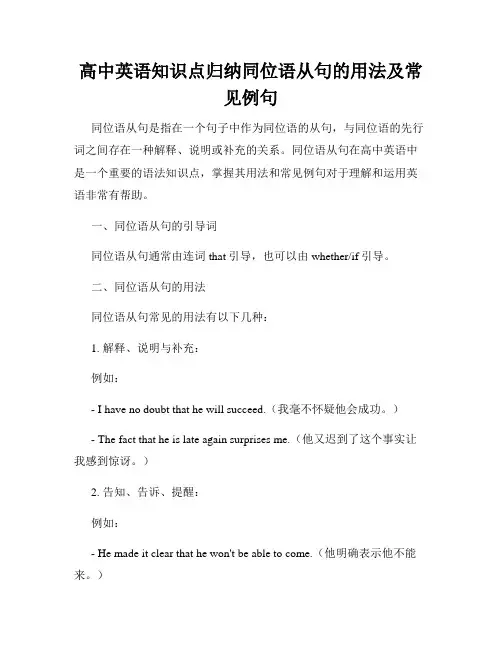
高中英语知识点归纳同位语从句的用法及常见例句同位语从句是指在一个句子中作为同位语的从句,与同位语的先行词之间存在一种解释、说明或补充的关系。
同位语从句在高中英语中是一个重要的语法知识点,掌握其用法和常见例句对于理解和运用英语非常有帮助。
一、同位语从句的引导词同位语从句通常由连词that引导,也可以由whether/if引导。
二、同位语从句的用法同位语从句常见的用法有以下几种:1. 解释、说明与补充:例如:- I have no doubt that he will succeed.(我毫不怀疑他会成功。
)- The fact that he is late again surprises me.(他又迟到了这个事实让我感到惊讶。
)2. 告知、告诉、提醒:例如:- He made it clear that he won't be able to come.(他明确表示他不能来。
)- Tom informed us that the party was canceled.(汤姆告诉我们聚会取消了。
)3. 想法、观点、看法:例如:- My belief is that hard work pays off.(我的信念是勤奋会有回报。
)- It is my opinion that education should be free for all.(我认为教育应该是免费的。
)4. 目的、原因:例如:- The purpose of the meeting is that everyone can express their opinions.(会议的目的是让每个人都能表达自己的观点。
)- The reason why he is angry is that you didn't inform him in advance.(他生气的原因是你没有提前告诉他。
)5. 疑问、不确定:例如:- I'm not sure if/whether he will come to the party.(我不确定他是否会来参加聚会。
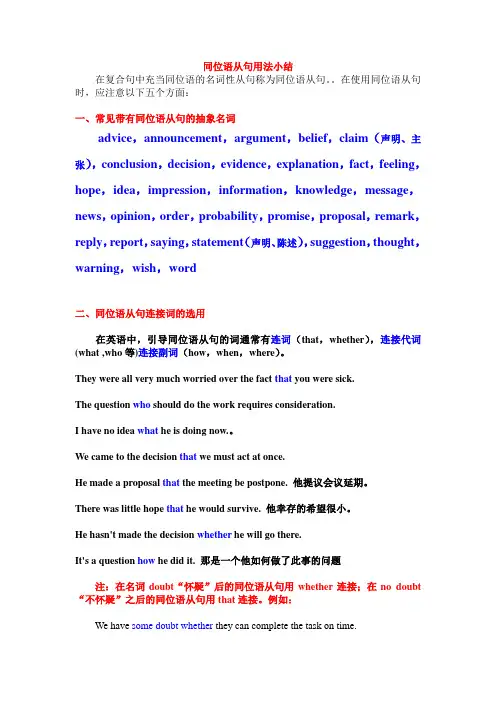
同位语从句用法小结在复合句中充当同位语的名词性从句称为同位语从句。
在使用同位语从句时,应注意以下五个方面:一、常见带有同位语从句的抽象名词advice,announcement,argument,belief,claim(声明、主张),conclusion,decision,evidence,explanation,fact,feeling,hope,idea,impression,information,knowledge,message,news,opinion,order,probability,promise,proposal,remark,reply,report,saying,statement(声明、陈述),suggestion,thought,warning,wish,word二、同位语从句连接词的选用在英语中,引导同位语从句的词通常有连词(that,whether),连接代词(what ,who等)连接副词(how,when,where)。
They were all very much worried over the fact that you were sick.The question who should do the work requires consideration.I have no idea what he is doing now.。
We came to the decision that we must act at once.He made a proposal that the meeting be postpone. 他提议会议延期。
There was little hope that he would survive. 他幸存的希望很小。
He hasn't made the decision whether he will go there.It's a question how he did it. 那是一个他如何做了此事的问题注:在名词doubt“怀疑”后的同位语从句用whether连接;在no doubt “不怀疑”之后的同位语从句用that连接。
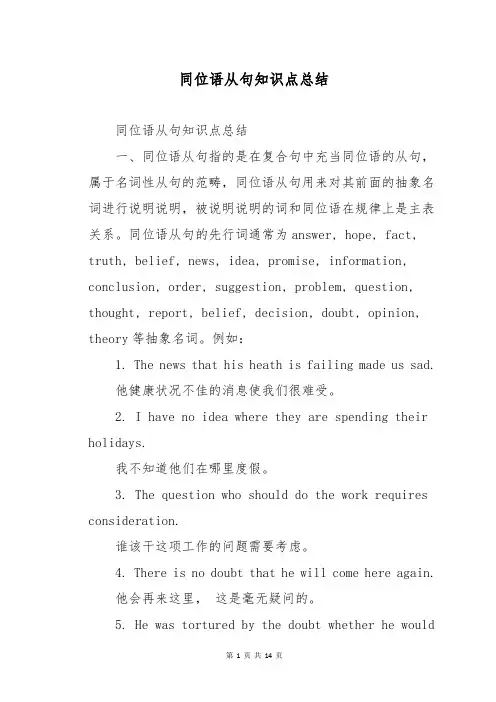
同位语从句知识点总结同位语从句知识点总结一、同位语从句指的是在复合句中充当同位语的从句,属于名词性从句的范畴,同位语从句用来对其前面的抽象名词进行说明说明,被说明说明的词和同位语在规律上是主表关系。
同位语从句的先行词通常为answer, hope, fact, truth, belief, news, idea, promise, information, conclusion, order, suggestion, problem, question, thought, report, belief, decision, doubt, opinion, theory等抽象名词。
例如:1. The news that his heath is failing made us sad.他健康状况不佳的消息使我们很难受。
2. I have no idea where they are spending their holidays.我不知道他们在哪里度假。
3. The question who should do the work requires consideration.谁该干这项工作的问题需要考虑。
4. There is no doubt that he will come here again.他会再来这里,这是毫无疑问的。
5. He was tortured by the doubt whether he wouldaccept their presents.他被是否接受他们的礼物这个疑虑所磨折着。
二、掌控同位语从句的用法要留意以下两个问题:1. 同位语从句有时可以不紧跟在它所说明的名词后面,而是被别的词隔开,以使得整个句子的结构显得平衡。
例如:He got the news from Mary that the sports meeting was put off. 他从玛丽那里获知了运动会被推迟的消息。
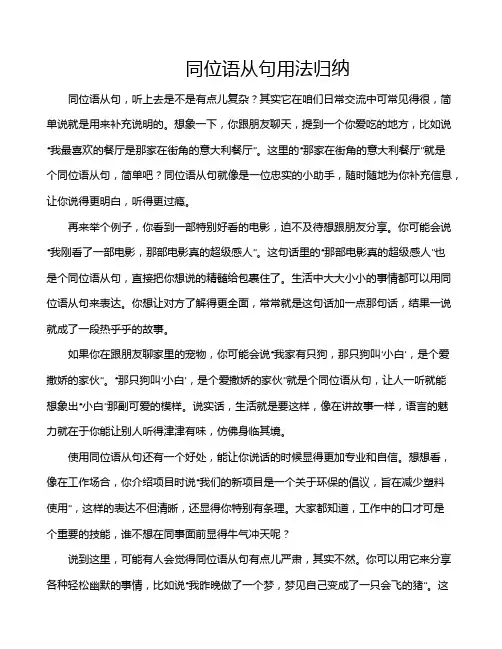
同位语从句用法归纳同位语从句,听上去是不是有点儿复杂?其实它在咱们日常交流中可常见得很,简单说就是用来补充说明的。
想象一下,你跟朋友聊天,提到一个你爱吃的地方,比如说“我最喜欢的餐厅是那家在街角的意大利餐厅”。
这里的“那家在街角的意大利餐厅”就是个同位语从句,简单吧?同位语从句就像是一位忠实的小助手,随时随地为你补充信息,让你说得更明白,听得更过瘾。
再来举个例子,你看到一部特别好看的电影,迫不及待想跟朋友分享。
你可能会说“我刚看了一部电影,那部电影真的超级感人”。
这句话里的“那部电影真的超级感人”也是个同位语从句,直接把你想说的精髓给包裹住了。
生活中大大小小的事情都可以用同位语从句来表达。
你想让对方了解得更全面,常常就是这句话加一点那句话,结果一说就成了一段热乎乎的故事。
如果你在跟朋友聊家里的宠物,你可能会说“我家有只狗,那只狗叫‘小白’,是个爱撒娇的家伙”。
“那只狗叫‘小白’,是个爱撒娇的家伙”就是个同位语从句,让人一听就能想象出“小白”那副可爱的模样。
说实话,生活就是要这样,像在讲故事一样,语言的魅力就在于你能让别人听得津津有味,仿佛身临其境。
使用同位语从句还有一个好处,能让你说话的时候显得更加专业和自信。
想想看,像在工作场合,你介绍项目时说“我们的新项目是一个关于环保的倡议,旨在减少塑料使用”,这样的表达不但清晰,还显得你特别有条理。
大家都知道,工作中的口才可是个重要的技能,谁不想在同事面前显得牛气冲天呢?说到这里,可能有人会觉得同位语从句有点儿严肃,其实不然。
你可以用它来分享各种轻松幽默的事情,比如说“我昨晚做了一个梦,梦见自己变成了一只会飞的猪”。
这样的表达让人忍不住笑出来,想象一下那只飞猪在空中翱翔的样子,简直是太搞笑了。
生活中有多少有趣的瞬间,我们都可以用同位语从句来记录和分享。
这就像是一种游戏,怎么把你想表达的意思用得更有趣、更有层次。
像是你对朋友说“我听说你最近在学吉他,那把吉他是你最喜欢的红色款式吧”。
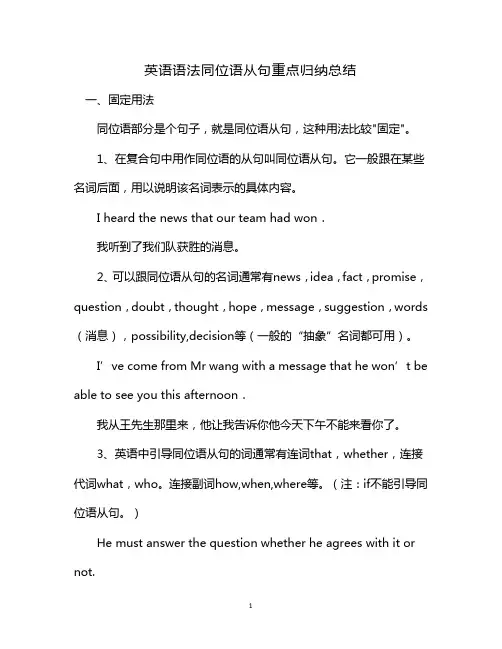
英语语法同位语从句重点归纳总结一、固定用法同位语部分是个句子,就是同位语从句,这种用法比较"固定"。
1、在复合句中用作同位语的从句叫同位语从句。
它一般跟在某些名词后面,用以说明该名词表示的具体内容。
I heard the news that our team had won.我听到了我们队获胜的消息。
2、可以跟同位语从句的名词通常有news,idea,fact,promise,question,doubt,thought,hope,message,suggestion,words (消息),possibility,decision等(一般的“抽象”名词都可用)。
I’ve come from Mr wang with a message that he won’t be able to see you this afternoon.我从王先生那里来,他让我告诉你他今天下午不能来看你了。
3、英语中引导同位语从句的词通常有连词that,whether,连接代词what,who。
连接副词how,when,where等。
(注:if不能引导同位语从句。
)He must answer the question whether he agrees with it or not.他必须回答他是否同意这样一个问题。
4、有时同位语从句可以不紧跟在说明的名词后面,而被别的词隔开。
The thought came to him that maybe the enemy had fled the city.他突然想起敌人可能已经逃出城了。
二、引导词同位语从句的引导词,引导同位语从句的词语通常有连词that,whether,连接代词和连接副词等。
1、that引导that连接从句时从句为一个句意完整的陈述句。
that不能省略,没有具体的意思,不充当句子成分,只起连接作用。
(注:引导同位语从句的that不能省略)The idea that you can do this work well without thinking is quite wrong.你认为不动脑筋就能做好这件工作的想法是完全错误的。
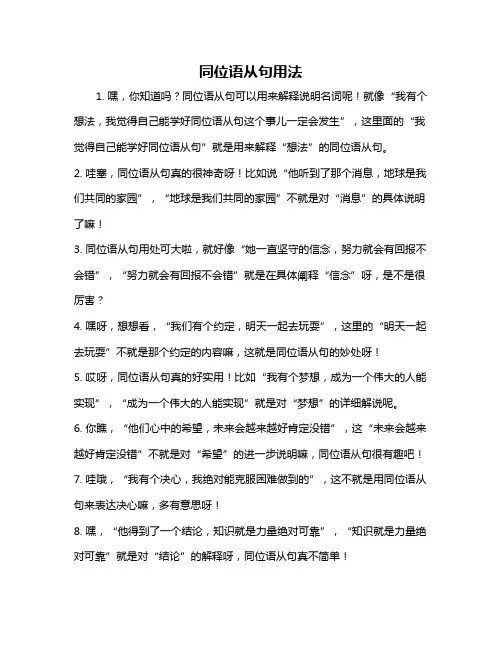
同位语从句用法
1. 嘿,你知道吗?同位语从句可以用来解释说明名词呢!就像“我有个想法,我觉得自己能学好同位语从句这个事儿一定会发生”,这里面的“我觉得自己能学好同位语从句”就是用来解释“想法”的同位语从句。
2. 哇塞,同位语从句真的很神奇呀!比如说“他听到了那个消息,地球是我们共同的家园”,“地球是我们共同的家园”不就是对“消息”的具体说明了嘛!
3. 同位语从句用处可大啦,就好像“她一直坚守的信念,努力就会有回报不会错”,“努力就会有回报不会错”就是在具体阐释“信念”呀,是不是很厉害?
4. 嘿呀,想想看,“我们有个约定,明天一起去玩耍”,这里的“明天一起去玩耍”不就是那个约定的内容嘛,这就是同位语从句的妙处呀!
5. 哎呀,同位语从句真的好实用!比如“我有个梦想,成为一个伟大的人能实现”,“成为一个伟大的人能实现”就是对“梦想”的详细解说呢。
6. 你瞧,“他们心中的希望,未来会越来越好肯定没错”,这“未来会越来越好肯定没错”不就是对“希望”的进一步说明嘛,同位语从句很有趣吧!
7. 哇哦,“我有个决心,我绝对能克服困难做到的”,这不就是用同位语从句来表达决心嘛,多有意思呀!
8. 嘿,“他得到了一个结论,知识就是力量绝对可靠”,“知识就是力量绝对可靠”就是对“结论”的解释呀,同位语从句真不简单!
9. 同位语从句真的是个超棒的语法点呀!可以让我们的表达更清晰更准确。
所以呀,好好掌握同位语从句,会让你的英语更上一层楼哟!。
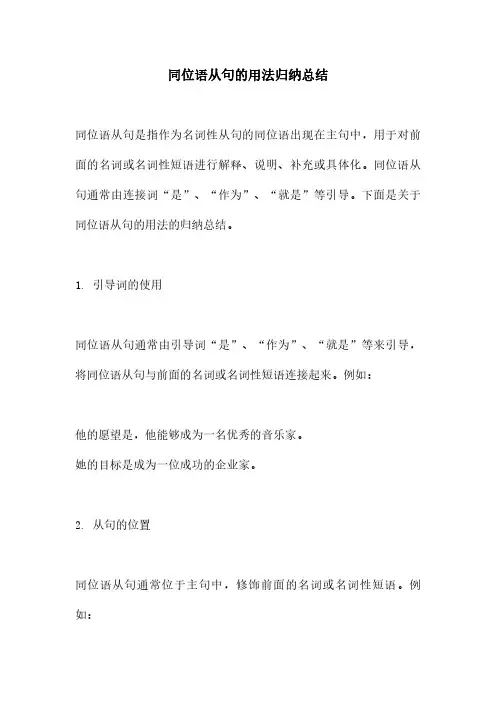
同位语从句的用法归纳总结同位语从句是指作为名词性从句的同位语出现在主句中,用于对前面的名词或名词性短语进行解释、说明、补充或具体化。
同位语从句通常由连接词“是”、“作为”、“就是”等引导。
下面是关于同位语从句的用法的归纳总结。
1.引导词的使用同位语从句通常由引导词“是”、“作为”、“就是”等来引导,将同位语从句与前面的名词或名词性短语连接起来。
例如:他的愿望是,他能够成为一名优秀的音乐家。
她的目标是成为一位成功的企业家。
2.从句的位置同位语从句通常位于主句中,修饰前面的名词或名词性短语。
例如:这个问题,我们需要弄清楚的是,如何提高客户满意度。
我听说的是,他正在考虑辞去现在的工作。
3.语序的转换同位语从句中的语序与主句的语序相同,即主语在前,谓语动词在后。
例如:他的梦想是成为一名科学家。
这个消息是我们得知的。
4.引导词的省略在某些情况下,同位语从句中的引导词可以省略,但意思仍然清楚。
省略引导词后,从句的语序与主句一致。
例如:我的愿望是你成功。
她的要求是我尽快完成这个项目。
5.同位语从句的种类同位语从句可以是名词从句、形容词从句或副词从句,具体取决于同位语从句在句子中的作用。
例如:名词从句:他的希望是他能够去旅行。
形容词从句:他的信心是他能够成功。
副词从句:他的计划是在明年开始。
同位语从句的运用可以使句子更加具体、详细,增加了句子的信息量,使文章更加丰富有趣。
在使用同位语从句时,需要注意引导词的选择和从句的位置,使句子表达清晰、连贯。
同位语从句的灵活运用可以提高文章的表达能力,使文章更加精彩。
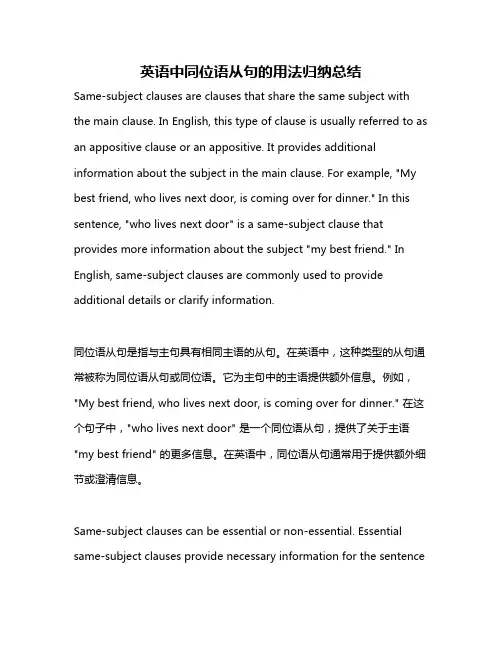
英语中同位语从句的用法归纳总结Same-subject clauses are clauses that share the same subject with the main clause. In English, this type of clause is usually referred to as an appositive clause or an appositive. It provides additional information about the subject in the main clause. For example, "My best friend, who lives next door, is coming over for dinner." In this sentence, "who lives next door" is a same-subject clause that provides more information about the subject "my best friend." In English, same-subject clauses are commonly used to provide additional details or clarify information.同位语从句是指与主句具有相同主语的从句。
在英语中,这种类型的从句通常被称为同位语从句或同位语。
它为主句中的主语提供额外信息。
例如,"My best friend, who lives next door, is coming over for dinner." 在这个句子中,"who lives next door" 是一个同位语从句,提供了关于主语"my best friend" 的更多信息。
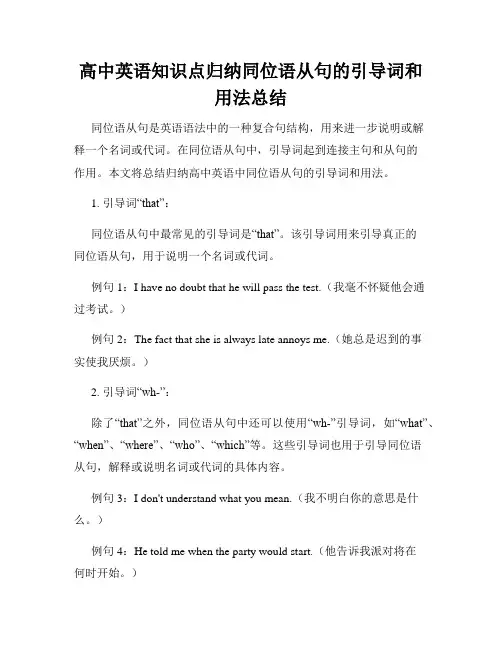
高中英语知识点归纳同位语从句的引导词和用法总结同位语从句是英语语法中的一种复合句结构,用来进一步说明或解释一个名词或代词。
在同位语从句中,引导词起到连接主句和从句的作用。
本文将总结归纳高中英语中同位语从句的引导词和用法。
1. 引导词“that”:同位语从句中最常见的引导词是“that”。
该引导词用来引导真正的同位语从句,用于说明一个名词或代词。
例句1:I have no doubt that he will pass the test.(我毫不怀疑他会通过考试。
)例句2:The fact that she is always late annoys me.(她总是迟到的事实使我厌烦。
)2. 引导词“wh-”:除了“that”之外,同位语从句中还可以使用“wh-”引导词,如“what”、“when”、“where”、“who”、“which”等。
这些引导词也用于引导同位语从句,解释或说明名词或代词的具体内容。
例句3:I don't understand what you mean.(我不明白你的意思是什么。
)例句4:He told me when the party would start.(他告诉我派对将在何时开始。
)3. 引导词“if”:在某些情况下,同位语从句中可以使用“if”作为引导词,用来表达条件或假设。
例句5:The question is if he will come to the meeting.(问题是他是否会来参加会议。
)4. 引导词“whether”:同位语从句中的另一个常见引导词是“whether”,用来引导一个选择性的同位语从句,表示两种或多种可能性。
例句6:I'm unsure whether she will accept the offer.(我不确定她是否会接受这个提议。
)5. 引导词“whoever”、“whatever”、“whichever”:有时,同位语从句中会使用“whoever”、“whatever”、“whichever”等引导词,用来引导一个无论哪个或无论什么的同位语从句。
同位语从句的用法和语序同位语从句是一种在句中充当同位语成分的从句结构。
它一般由连接词“是”、“叫”、“为”等引导,用来解释、补充或说明名词的内容。
同位语从句的使用可以使句子更加简洁明了,表达更加准确。
本文将详细介绍同位语从句的用法和语序,并为读者提供一些例句以便更好地理解。
一、同位语从句的用法:同位语从句在句中作为同位语成分,用来说明名词的具体内容或进一步解释名词的含义。
常见的连接词包括“是”、“叫”、“为”等。
下面是一些常见的例句,用来说明同位语从句的用法:1. 他的愿望是获得一份令人满意的工作。
(同位语从句“获得一份令人满意的工作”进一步解释了“愿望”的具体内容)2. 我听说你将是我们班的班长。
(同位语从句“你将是我们班的班长”进一步解释了“听说”的内容)3. 我的梦想是成为一名优秀的作家。
(同位语从句“成为一名优秀的作家”说明了“梦想”的具体内容)二、同位语从句的语序:同位语从句的语序一般为陈述句语序,即主语+谓语+宾语的结构。
以下是一些例句,展示了同位语从句的语序:1. 我的希望是她能够顺利通过考试。
2. 我的信心是我们一定会取得胜利。
3. 我的目标是成为一名优秀的工程师。
4. 我的愿望是未来能够和你一起实现。
同位语从句的语序与主句保持一致,不会受到连接词的影响。
它丰富了句子的结构,使得句子更具表达力。
总结:同位语从句的用法和语序是在句子中作为同位语成分,用来解释、说明或补充名词的内容。
常见的连接词包括“是”、“叫”、“为”等。
同位语从句的语序一般为陈述句语序,与主句保持一致。
掌握同位语从句的用法和语序能够帮助我们更准确地表达自己的意思,使句子更加丰富多样。
同位语从句的使用可以使句子更简洁明了,并且可以用来加强对名词的解释和说明。
通过不断练习和运用,我们可以更好地掌握同位语从句的用法和语序,从而提升自己的写作水平。
希望本文对读者有所帮助,谢谢阅读!。
同位语从句⽤法⼩结、长句的分析2019-08-23⼀、同位语从句⽤法⼩结在复合句中作名词的同位语的名词性从句被称为同位语从句。
它⼀般跟在某些名词后⾯,对该名词作进⼀步解释,说明其具体内容,同位语从句⼀般由that引导。
同位语从句是⾼中英语教学中的重点语法知识之⼀,在近⼏年的⾼考试题中频频出现。
2011年⾼考考了3道同位语从句题(上海卷第35题,辽宁卷第32题,天津卷第13题);2012年⾼考考了3道同位语从句题(重庆卷第34题,浙江卷第4题,江苏卷第27题)。
因此掌握好同位语从句显得尤为重要。
下⾯通过对近⼏年全国各地⾼考试题中出现的同位语从句的分析,对其做⼀简单的⼩结:(⼀)同位语从句在复合句中的位置1.⼀般情况下,同位语从句通常跟在某些名词后⾯,⽤来解释或说明该名词所表达的具体内容。
常见的可以跟同位语从句的词(抽象名词)有:belief,news,idea,truth,hope,rumor,problem,information,promise,evidence,message,possibility,fact,word(消息)等。
A wonderful idea suddenly occurred to me that I could turn to the reference book to finish my homework. 我突然有了⼀个好主意,我可以查阅参考书来完成我的作业。
Evidence has been found that drinking water after getting up in the morning contributes to one's health. 有证据证明,早晨起床后喝⽔对⾝体有好处。
⾼考链接:Modern science has given clear evidence________smoking can lead to many diseases.A. whatB. whichC. thatD. where(2011天津卷)【答案】 C。
高中会考英语同位语从句知识点总结高中会考英语同位语从句知识点总结同位语从句就是在复合句中作名词的同位语的名词性从句。
1. 同位语从句的功能同位语从句对于名词进一步解释,说明名词的具体内容,一般由that引导,例如:1) The king’s decision that the prisoner would be set free surprisedall the people.2) The order that all the soldiers should stay still is given by thegeneral.2. 同位语在句子中的位置同位语从句有时可以不紧跟在它所说明的名词后面,而是被别的词隔开。
例如:He got the news from Mary that the sports meeting was put off.3. 同位语从句与定语从句的区别(1) 定语从句中的that既代替先行词,同时以在从句中作某个成分(主语或宾语),而同位语从句中的that是连词,只起连接主句与从句的'作用,不充当句中任何成分。
(2) 定语从句是形容词性的,其功能是修饰先行词,对先行词加以限定,描述定的性质或特征;同位语从句是名词性的,其功能是对名词进行补充说明。
例如:1) The news that he told me is that Tom would go abroad next year.(他告诉我的消息是汤姆明年将出国。
)(第一个that引导的从句是定语从句,that在从句中作宾语)2)The news that Tom would go abroad is told by him.(汤姆将出国的消息是他讲的。
)(同位语从句,that在句中不作任何成分) 高中英语名词性从句专项练习1.____he does has nothing to do with me.A. whateverB. No matter whatC. ThatD. If2. The manager came over and asked the customer how____A. did the quarrel came about B .the quarrel had come aboutC. had the quarrel come aboutD. had the quarrel come about3.Energy is ____makes thing work..A. whatB. somethingC. anythingD. that4. Information has been put forward ____ more middle school graduates will be admitted into universities.A. whileB. thatC. whenD. as5.This is ___the Shenzhou V Spaceship landed.A. thereB. in whichC. whereD. when6. They have no idea at all____.A. where he has goneB. where did he goC. which place has he goneD. where has he gone7.T he doctor did a lot to reduce the patient’s fear ____he woulddie of the disease.A. thatB. whichC. of whichD. of that8. The order came ___the soldiers ____the small village the nextmorning.A. that ;had to leaveB. that; should leaveC. /; must leaveD. when; should leave9.___is no possibility ____Bob can win the first prize in the match.A. There; thatB. It; thatC. there; whetherD. It; whether10. The question came up at the meeting_____ we had enough money forour research.A. thatB. whichC. whetherD. if答案:1~5 A B A B C6~10 A A B A C。
初中英语中考复习同位语从句重点归纳总结同位语从句是英语语法中的一个重要语法结构,常常出现在中考英语中。
同位语从句的作用是补充说明或解释同位语的内容,并且它通常用来修饰名词。
因此,对于中考英语来说,同位语从句是需要我们关注和掌握的语法之一。
下面是同位语从句的一些重点归纳和总结。
一、同位语从句的定义同位语从句通常由一个名词后面的一句话组成。
它可以被理解为一个补充说明或解释名词的内容的句子。
例如:The news that he told me was surprising.在这个句子中,“that he told me”就是一个同位语从句,它是用来修饰名词“news”的。
它的作用是表达新闻的内容是什么,也就是说这个同位语从句是用来说明或解释与之相关的名词。
二、同位语从句的结构同位语从句的结构是“名词+从句”,其中的从句可以是一个宾语从句、主语从句或表语从句。
例如:The fact that he is leaving makes me sad. (表语从句)I heard the rumor that my favorite singer is coming to town. (宾语从句)His dream that he would become a president came true. (主语从句)三、同位语从句的引导词同位语从句通常由引导词引导,常见的引导词包括that、whether、if、who、whom、what、which、whichever、whoever、whomever等。
不过,在口语中,that通常可以省略不写。
例如:I don't know whether he is coming or not.Do you know what time it is?She asked me who was the best singer in the world.四、同位语从句的语序同位语从句的语序通常为陈述语序。
高中英语同位语从句知识点整理1. 定义:用作同位语的从句叫做同位语从句。
2. 用法:同位语从句的先行词多为fact, news, idea, thought, question, reply, report, remark等,关联词多用从属连词that。
例如:they were all very much worried over the fact that you were sick. 对你生病这件事,他们都很焦虑。
where did you get the idea that i could not come? 你在哪儿听说我不能来?注:同位语从句偶尔由从属连词whether引导。
例如:i have no idea whether he'll come or not. 我不知道他是否来。
连接代词who, which, what和连接副词where, when, why, how 亦可引导同位语从句。
例如:the question who should do the work requires consideration. 谁该干这项工作,这个问题需要考虑。
it is a question how he did it. 那是一个他如何做了此事的问题。
注:1.一些表示“建议、命令、要求”的名词后所跟的同位语从句中,谓语动词用虚拟语气should+动词原形表示。
should可省。
例如:this is our only request that this (should) be settled as soon as possible. 这就是我们唯一的请求:尽快解决这个问题。
2.引导词that在同位语从句中不作句子成分;而在定语从句中必作句子成分,是从句所修饰的词的替代词。
例如:the fact that the chinese people invented the compass is known to all.中国人发明指南针这个事实是众所周知的。
同位语从句用法知识点总结同位语从句是英语语法中的一种复杂句结构,它作为名词的同位成分出现,起到进一步解释、说明、补充名词的作用。
在句子中,同位语从句往往与主句的名词存在关系,用于对该名词进行进一步描述、解释或具体化。
下面是同位语从句的几种常见用法及相关注意事项的总结。
1. 同位语从句的引导词:同位语从句通常由“that”引导,作为名词的补充说明。
例如:- I have no idea that he is leaving.(我不知道他要离开。
)- I heard the news that she got married.(我听说她结婚了。
)2. 同位语从句的内容:同位语从句的内容通常是对名词进行解释或具体化的句子。
例如:- The fact that he passed the test surprised everyone.(他通过了考试这个事实让大家感到惊讶。
)- My dream is that I can travel around the world.(我梦想能够环游世界。
)3. 同位语从句与关系从句的区别:同位语从句与关系从句在引导词和作用上有所不同。
同位语从句是对名词进行解释、具体化,而关系从句是对名词进行限制、修饰。
例如:- I believe that he will succeed.(同位语从句,解释名词“believe”)- I trust the person who promised to help me.(关系从句,限制名词“person”)4. 注意同位语从句的标点符号:同位语从句引导词“that”通常不需要逗号隔开,而与主句的联系紧密,直接连接在名词后面。
但在口语或强调句中,可用逗号将同位语从句与主句分开。
例如:- The fact that he didn't come to the party disappointed me.(同位语从句与主句直接连接)- Her biggest wish, that she could meet her idol, finally came true.(用逗号将同位语从句与主句隔开)5. 常见的同位语从句的名词:同位语从句可以出现在很多不同类型的名词之后。
同位语从句用法小结
在复合句中充当同位语的名词性从句称为同位语从句。
在使用同位语从句时,应注意以下五个方面:
一、常见带有同位语从句的抽象名词
advice,announcement,argument,belief,claim(声明、主张),conclusion,decision,evidence,explanation,fact,feeling,hope,idea,impression,information,knowledge,message,news,opinion,order,probability,promise,proposal,remark,reply,report,saying,statement(声明、陈述),suggestion,thought,warning,wish,word
二、同位语从句连接词的选用
在英语中,引导同位语从句的词通常有连词(that,whether),连接代词(what ,who等)连接副词(how,when,where)。
The question who should do the work requires consideration.
I have no idea what he is doing now.。
There was little hope that he would survive. 他幸存的希望很小。
He hasn't made the decision whether he will go there.
It's a question how he did it. 那是一个他如何做了此事的问题
注:在名词doubt“怀疑”后的同位语从句用whether连接;在no doubt“不怀疑”之后的同位语从句用that连接。
例如:
There is no doubt that Tom will keep his promise.
三、同位语从句在句中的位置
1. 一般情况下同位语从句跟在某些名词(如news,idea,fact,promise,hope,message等)的后面,用以说明该名词所表达的具体内容。
例如:
The news that our women volleyball team had won the championship encouraged us all greatly.
2. 有时同位语从句可以不紧跟在它所说明的名词后,而被别的词语隔开,在语法上叫做分隔式同位语从句。
例如:
The thought came to her that maybe she had left the door open when she left home.
四、同位语从句的语气
在suggestion,advice,request,order等意为“建议;命令;要求”的名词后,同位语从句中的谓语动词通常用“should +动词原形”的虚拟语气结构,句中的should可以省略。
例如:
Our teacher gave us some advice how we(should)use the computer.
The suggestion came from the chairman that the new rule(should)be adopted.
The government gave the order that all these houses(should)be pulled down in three weeks. 政府下令三个星期内所有这些房子都要拆掉。
五、同位语从句与定语从句的用法区别
区别(1)that在同位语从句中没有词义,不充当句子成分;而在定语从句中充当主语、宾语等句子成分。
区别(2)同位语从句和先行词是同等的关系;而定语从句是用来修饰先行词,是从属的关系。
区别(3)whether,what,how可以用来引导同位语从句;而它们不能用来引导定语从句。